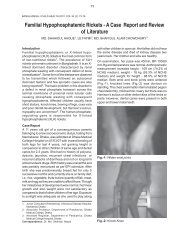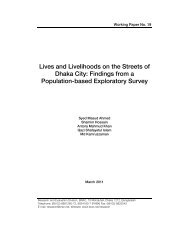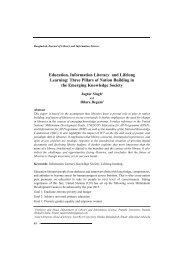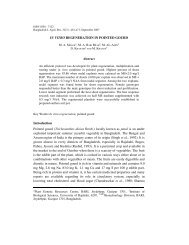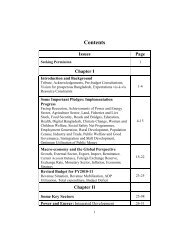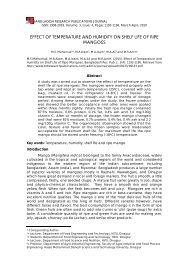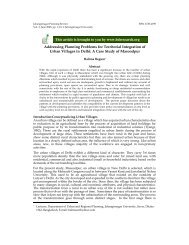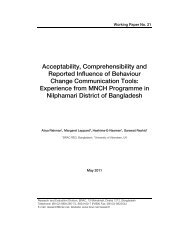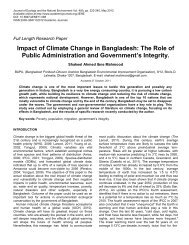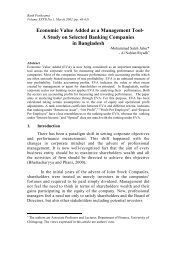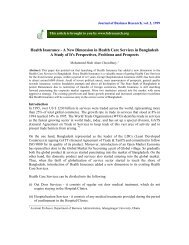Studies on Policy Option for Quality Seed Production and ... - NFPCSP
Studies on Policy Option for Quality Seed Production and ... - NFPCSP
Studies on Policy Option for Quality Seed Production and ... - NFPCSP
You also want an ePaper? Increase the reach of your titles
YUMPU automatically turns print PDFs into web optimized ePapers that Google loves.
4.3.20 Producti<strong>on</strong> package of maize in DinajpurOnly Rabi maize was cultivated in this area, there was no Kharif-1 maize. The existing cultivati<strong>on</strong>practices of Rabi maize is described below.L<strong>and</strong> <strong>and</strong> soil type: Maize is cultivated in high <strong>and</strong> medium high l<strong>and</strong>s. Soils <strong>for</strong> maize are s<strong>and</strong>yloam <strong>and</strong> loamy in nature.L<strong>and</strong> preparati<strong>on</strong> <strong>and</strong> planting: In this locality farmers grow <strong>on</strong>ly Rabi maize. They usually ploughtheir l<strong>and</strong>s during 15 November to 15 December <strong>and</strong> complete l<strong>and</strong> preparati<strong>on</strong>. Only 2 ploughings areenough <strong>for</strong> sowing seed. Farmers sow seed <strong>on</strong> the day of final l<strong>and</strong> preparati<strong>on</strong> or the following day.<strong>Seed</strong>s are sown in lines 65-70 cm apart. Furrows are made by old wooden plough. <strong>Seed</strong> to seed distanceis 20-25 cm with seed rate of 15-18.5 kg/ha depending <strong>on</strong> seed size <strong>and</strong> sparing. Farmers are using <strong>on</strong>lyhybrid seeds of different varieties from different seed companies. Usually seeds are free fromadmixture. Again as the crops are grown not <strong>for</strong> seed saving, rouging is not necessary.Source of seed: <strong>Seed</strong>s are collected from seed dealers or retailers. <strong>Seed</strong>s are supplied in packs of 1-2kg. <strong>Seed</strong>s are collected 5-7 days be<strong>for</strong>e sowing. Farmers have faith <strong>on</strong> the seeds in sealed pack <strong>and</strong> thesource. Farmers become assured after harvesting the crop. They do not store seed in their house. Theyhave seldom experience about failure of seed germinati<strong>on</strong>.Manure <strong>and</strong> fertilizer use pattern: Farmers use cow dung/compost from their own source or bypurchasing from others. They apply cow dung/compost be<strong>for</strong>e starting ploughing in various amounts, 6-6.5 t/ha. The amount of chemical fertilizers is:During final l<strong>and</strong> preparati<strong>on</strong> (basal):Urea : 100-125 kg/haTSP : 50-125 kg/haMP : 55-120 kg/haGypsum : 100-150 kg/haZinc sulphate : 15 kg/haBorax : 10 kg/haMagnesium sulphate : 8 kg/haTop-dressing urea: 30-35 days when a basal of 150 kg/ha was used <strong>and</strong> 65-70 days after sowing when100-125 kg/ha was used as basal. Top dressing of urea is followed by earthing-up. Weeds are cleaned/c<strong>on</strong>trolled by mechanical weeding twice by spading.Disease <strong>and</strong> pest management: Cutworm is a major insect pest. Cutworm can be c<strong>on</strong>trolled by killingit by h<strong>and</strong> or by irrigating the field. Darsban is an effective insecticide <strong>for</strong> c<strong>on</strong>trolling this insect. It isused at rate of 30ml/10L of water <strong>for</strong> 5-8 decimal of l<strong>and</strong>. There is no evidence of occurring disease inmaize.Irrigati<strong>on</strong> <strong>and</strong> water management: Farmers usually apply 4-5 irrigati<strong>on</strong>s in intervals of <strong>on</strong>e m<strong>on</strong>th.First <strong>on</strong>e is applied as flood irrigati<strong>on</strong>. The following irrigati<strong>on</strong>s <strong>on</strong>e applied in the farrows made up inbetweentwo lines of maize.96



